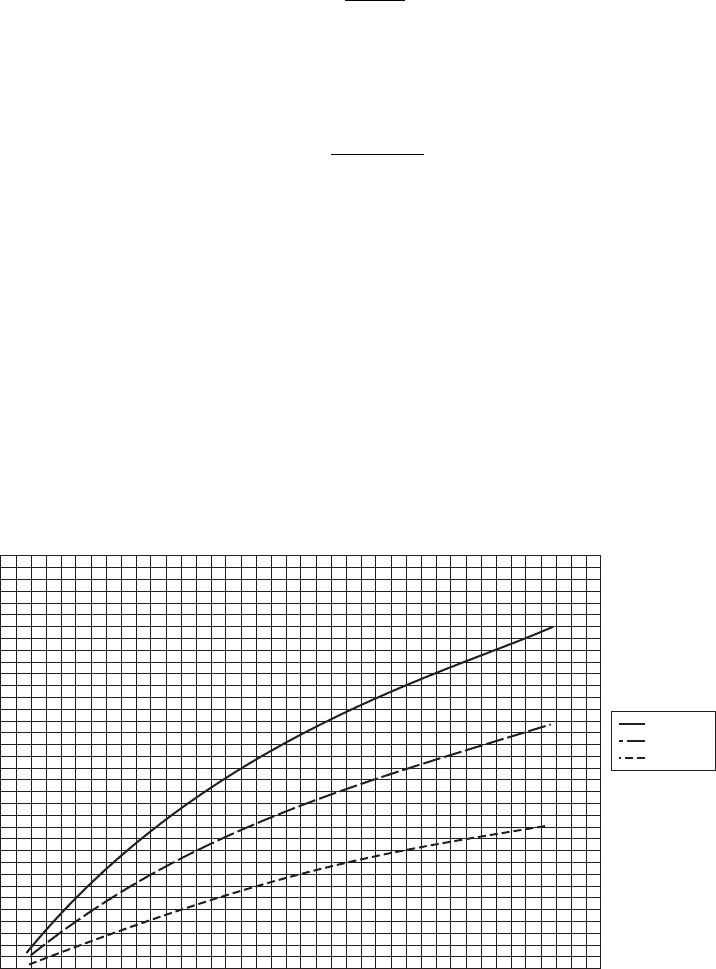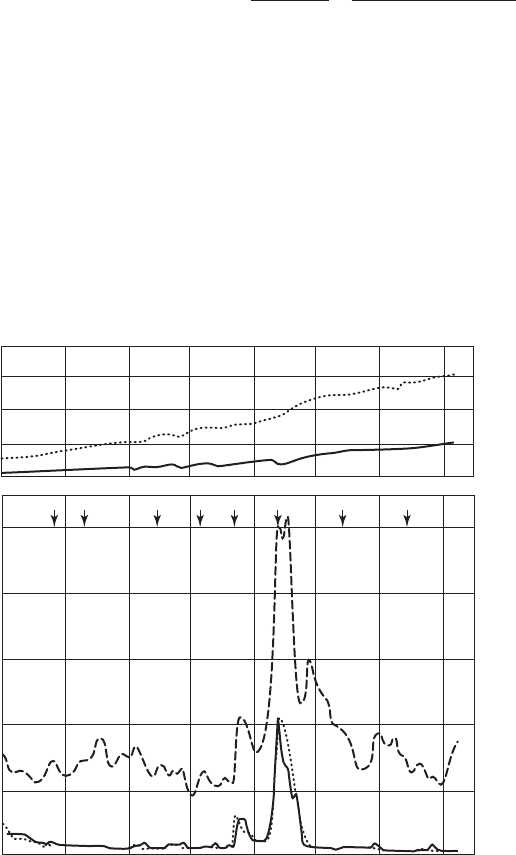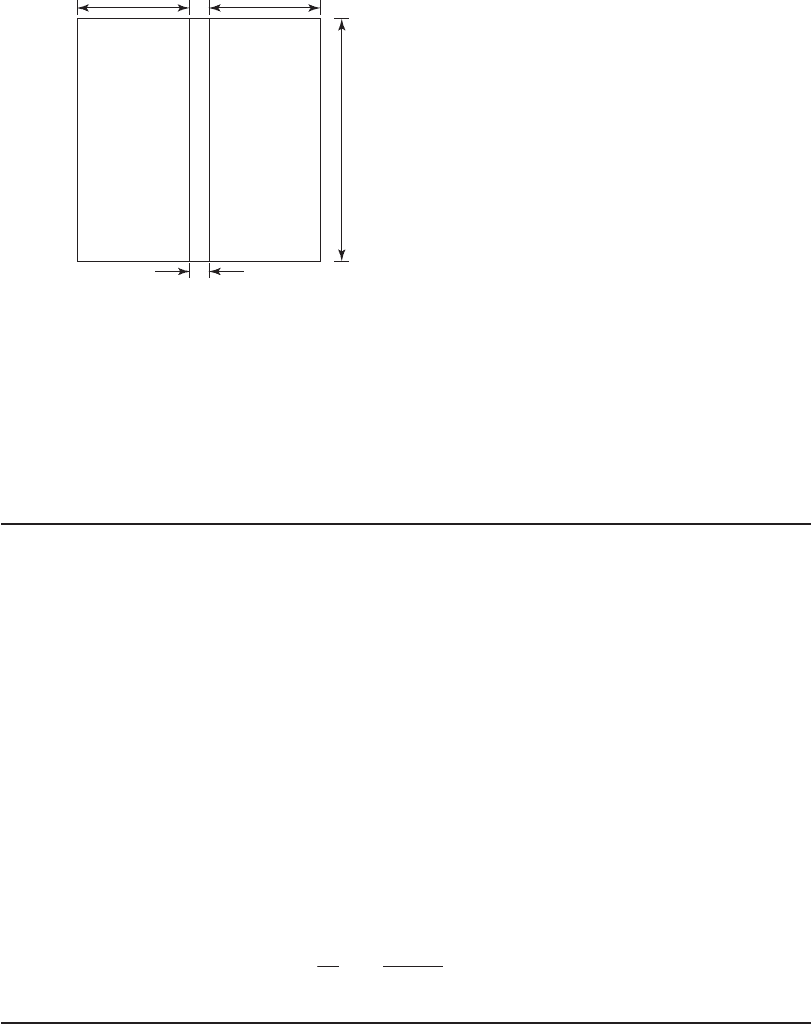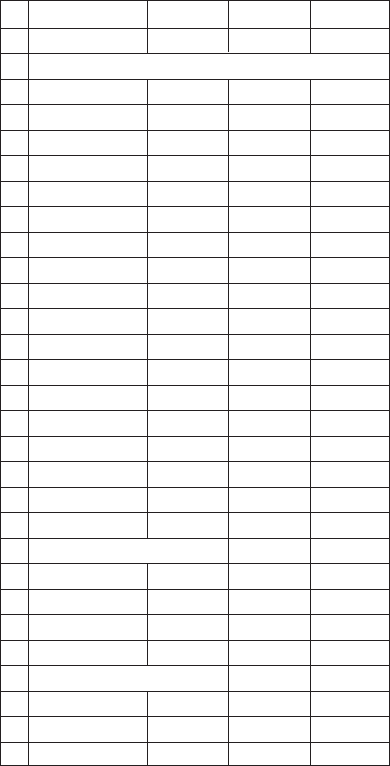Water and Wastewater Engineering
Подождите немного. Документ загружается.


11-16 WATER AND WASTEWATER ENGINEERING
The last column is summed and the headloss calculated using Equation 11-9 :
h
L
1 067 0 0025 0 5
082 981
2
.. .
..
()()
()(
m/sm
m/s
224
1
5 2
045
75 025
1 0119 10 75 0
)( )
()
()(
.
,
.,
m
m
225 076
1
mm
).
Comments:
1 . This headloss is large for clean bed filtration. It should be less than 0.6 m for the specified
loading rate. Comparison of the effective size and uniformity coefficient for this sand (from
E xample 11-1 ) with the typical values in Table 11-1 reveals that the uniformity coefficient
is too high. As noted later in this chapter (s
ee p. 11-22), the loading rate is high for a stan-
dard sand filter. Either the loading rate should be lowered, the fraction of fines should be
reduced, or some combination of less fines and a lower loading rate should be employed.
2. Note that the equation used to calculate C
D
changed when the Reynolds number dropped
below 0.5.
3. As may be noted from the number of significant figures presented, this calculation was
performed on a spreadsheet.
Terminal Headloss. As the filter clogs, the headloss will increase so that the results calculated
using the clean bed eq
uations are the minimum expected headlosses. There is no method to pre-
dict the increase in headloss as the filter becomes plugged with accumulated solids without full-
scale or pilot plant data. The phenominological model ( Equations 11-7 and 11-8 ) provides a way
to obtain estimates of the tim
e to reach terminal headloss using pilot plant data. More typically,
terminal headloss pressure is selected based on experience and the hydraulic profile of the entire
treatment plant.
Backwashing Hydraulics
The expansion of the filter bed during backwash is calculated to provide a starting point in
determining the placement of the backwash troughs above the filter bed. Fair and Geyer (1954)
developed the following relationship to predict the depth of the expanded bed:
D
D
f
e
e
()()
()
1
1
(11-11)
where D
e
depth of the expanded bed, m
porosity of the bed
D depth the unexpanded bed, m
f mass fraction of filter media with expanded porosity
e
porosity of expanded bed
The conditions during backwash are turbulent. A representative model equation for estimating
e
is that given by Richardson and Zaki (1954):
e
b
s
v
v
⎛
⎝
⎜
⎞
⎠
⎟
0 2247
01
.
.
R
(11-12)

GRANULAR FILTRATION 11-17
where v
b
is the backwash velocity and the Reynolds number is defined as
R
()()vd
s
(11-13)
The ex panded porosity is calculated for each fractional s ize of the media and summed for the
entire bed. An approximation technique uses the 60th percentile diameter ( d
60%
in m) to calculate
the Reynolds number,
R
()( )vd
s%60
(11-14)
and then calculates the expanded porosity in one step for the entire bed depth (Cleasby, 1972). A
more sophisticated model developed by Dharmarajah and Cleasby (1986) is also available.
The determination of D
e
i s not straightforward. From Equation 11-12 , it is obvious that
the expanded bed porosity is a function of the settling velocity. The particle settling velocity is
determined by Equation 10-8 in Chapter 10. To solve Equation 10-8, the drag coefficient ( C
D
)
must be calculated. The drag coefficient is a function of the Reynolds number, which, in turn, is
a function of the settling velocity. Thus, the settling velocity is needed to find the settling veloc-
ity! To resolve this dilemma, the settling velocity must be estimated. Knowing the sand grain
diameter and specific gravity, Figure 11-7 can be used to obtain a first es timate for the settling
velocity to use in calculating the Reynolds number. The calculated value of the Reynolds number
is compared to the estimate, and the procedure is iterated until the estimate and the c
alculated
value of R are the same.
E xample 11-3 illustrates the calculation procedure to estimate D
e
.
0
0
0.1
0.2
0.3
0.4
0.5
0.6
0.7
0.0005 0.001 0.0015 0.002 0.0025
S.G. = 4
S.G. = 2.6
S.G. = 1.6
Particle diameter, m
Esrimated setting velocity, m/s
0.003 0.0035 0.004
FIGURE 11-7
Particle settling velocity estimation chart. S. G. specific gravity.

11-18 WATER AND WASTEWATER ENGINEERING
Example 11-3. Determine the depth of the expanded sand filter bed being designed for Ottawa
Island ( Example 11-2 ).
Solution. To begin, select a backwash rate. To retain the finest sand grains used in building the
filter, the backwash rate must not wash out particles with a diameter of 0.000126 m (0.0126 cm).
Using Figure 11-7 , find that for a 0.0126 cm partic
le with a specific gravity of 2.65, the terminal
settling velocity is approximately 1 cm/s (864 m/d).
The computations are shown below.
Sieve no. Dia., m
Estimated
v
s
, m/s
Estimated
Reynolds
number C
D
v
s
, m/s
Fraction
retained
Reynolds
number Exponent
Expanded
porosity f/(1
e
)
8–12 0.002 0.3376.43 0.56 0.277891 0.053 425.23 0.412 0.255 0.071
12–16 0.00142 0.2 178.18 0.70 0.209215 0.171 227.300.387 0.309 0.247
16–20 0.001 0.15 94.11 0.90 0.15441 0.146 118.14 0.362 0.371 0.232
20–30 0.000714 0.1 44.80 1.32 0.107828 0.204 58.91 0.338 0.448 0.369
30–40 0.000505 0.07 22.18 2.06 0.072715 0.176 28.10 0.314 0.5370.380
40–50 0.000357 0.05 11.20 3.38 0.047723 0.119 13.04 0.290 0.635 0.326
50–70 0.000252 0.03 4.74 6.78 0.028313 0.059 5.46 0.266 0.758 0.244
70–100 0.000178 0.02 2.23 1
3.09 0.017121 0.0312.33 0.245 0.877 0.252
100–140 0.000126 0.015 1.19 23.34 0.01079 0.007 1.04 0.226 0.983 0.412
Sum 0.966 Sum 2.53
The estimated settling velocities in the third column were found from Figure 11-7 . The Reynolds
number was then computed with this estimated velocity. For the first row:
R
()()( ) ( )( )( ) d v
a
082 0002 030
130
.. .
.
m m/s
7710
376 435
62
m/s
.
Note that the shape factor, sand particle diameter, and viscosity are all the same as in Example 11-2 .
The drag coefficient ( C
D
) is calculated in the same fashion as Example 11-2 . The settling velocity is
calculated using Equation 10-8 assuming the density of water is 1,000 kg/m
3
. For the first row:
v
s
12
2 3
4981 2650 1 000
/
m/s kg/m kg/m()( )(., ,
33
3
0 002
3 0 55838 1 000
)( )
()( )( )
.
.,
m
kg/m
⎡
⎣
⎢
⎤
⎦
⎥
0 2778839. m/s
The density of the sand grain is the product of the specific gravity (from Example 11-2 ) and the
density of water:
s
()( )2 65 1 000 2 650
33
., ,kg/m kg/m

GRANULAR FILTRATION 11-19
The expanded bed porosity (next to last column) is calculated from Equations 11-12 and 11-13 .
For the first row d 0.002 and
R
()( )0 002 0 2778839
1 307 10
425
62
.. s
. s
mm/
m /
..22
R
0.1
1.83
and
0.2247 R
0.1
0.41
and
e
041
001
0 277884
0 255
.
.
.
.
m/s
⎛
⎝
⎞
⎠
The first row of the last column is then
f
e
1
0053
10255
0 0711
.
.
.
()
where 0.053 is the mass frac tion of sand having a geometric mean diameter of 0.002 m, that is,
between sieve numbers 8 and 12.
U sing Equation 11-11 with a porosity of 0.45 and an undisturbed bed depth of 0.5 m from
E xample 11-2 , the depth of the expanded be
d is then
D
e
()()()
1045 0 5 2 53 0070. . . .696 or .mm
Comments:
1 . The expansion ratio is D
e
/ D 1.40 or a 40% bed expansion.
2. The depth of the expanded bed is the starting point for setting the elevation of the back-
wash troughs. In this case it wou ld be D
e
D 0.70 m 0.5 m 0.2 m above the
undisturbed bed surface plus a factor of safety.
3. The “one-step” calculation procedure yields a D
e
of 0.60 m.
The hydraulic headloss that occurs during backwashing is calculated to determine the head
required for the backwash pumps. The loss of head in expanding the filter is calculated as the
gravitational force of the entire expanded bed:
F a Dg
g
see
mg ()()()()()1
(11-15)
where F
g
gravitational force of the expanded filter bed, N
m mass of bed, kg/m
3
g acceleration due to gravity, 9.81 m/s
2
s
density of media, kg/m
3
density of water, kg/m
3
e
porosity of expanded bed
a cross-sectional area of filter bed, m
2
D
e
depth of expanded bed, m

11-20 WATER AND WASTEWATER ENGINEERING
Converting to pressure by dividing by the area of the bed and converting units of pressure (N/m
2
)
to units of head (m):
h
F
a
g
D
Le
g
see
()()()
()()()
1
(11-16)
11-6 GRANULAR FILTRATION PRACTICE
Filter Type
The selection of the type of filter is strongly influenced by the characteristics of the raw water
and treatment processes that precede and follow the filter. Deep bed anthracite monomedia filters
accumulate headloss at a low rate, and they have a high capacity for accumulating solids. This
leads to long filter runs. However, when the water is not conditione
d properly because of high
variability in the raw water quality ( Figure 11-8 ), improper chemical dosage, or lack of opera-
tor vigilance, the performance degrades dramatically. Dual-media filters provide a more robust
0
0
1
2
3
4
5
0
0.6
Headloss, m
1.2
1.8
2.4
6555 3025300 200 85 80
20 40 60
Time, hr
Turbidity units
80 100 120 140
FIGURE 11-8
T urbidity values at filtration rates of 117 and 293 m
3
/d m
2
. In the upper graph, the dotted curve is for 293 m
3
/ d m
2
; the solid,
117 m
3
/d m
2
. In the lower graph, the numbers at the top are the raw-water turbidity values at the time shown during the run; the
dashed curve is for filter influent; the dotted for filter effluent at 117 m
3
/d m
2
; and the solid for filter effluent at 293 m
3
/ d m
2
.
( Source: G. G. Robeck, K. A. Dostal, and R. L. Woodward, “Studies of Modification in Water Filtration,” Jour. AWWA,
56(2), February 1964: 198.)

GRANULAR FILTRATION 11-21
design when the raw water is improperly conditioned. Rapid sand filters have been in use for
over a century. They have proven reliable but are limited in that the finest sand is on the top. As
a result, the smallest pore spaces are also on the top. Therefore, most of the particles will clog in
the top layer of the filter and only a small portion of the filter depth will be used. Because of the
clogging of the
small pore spaces, headloss is quickly accumulated and the length of the filter run
is shorter than with the coarse media.
Softened grou ndwater has the most consistent water quality over long periods of time. In
addition, the precipitate floc is very tough. Each of the three different media filters perform well.
D ual- or multimedia filters are favored when the raw water source is a large lake such as
Lake Michigan. They are recommended for rivers with seasonal flooding, that res
ults in large,
rapid changes in turbidity over short periods of time.
Monomedia filters are preferred when the water s ource characteristics change only slowly
with time and when chemical conditioning can keep pace with the changes.
Number
For smaller plants ( 8,000 m
3
/ d), the minim um number of filters is two. For plants with a de-
sign capacity greater than 8,000 m
3
/ d, the minimum number of filters is four. A rule-of-thumb
estimate for larger plants may be made using Kawamura’s suggestion (2000):
N 0 0195
0 5
.
.
()Q
(11-17)
where N total number of filters
Q maximum design flow rate, m
3
/ d
Example 11-4. Estimate the number of filters for Ottawa Island’s new water treatment plant
( Examples 11-1 , 11-2 , 11-3 ) if the maximum day design flow rate is 18,400 m
3
/ d.
Solution. Using Equation 11-17 , the number of filters is
N 0 0195 18 400 2 65
0 5
., .
.
()
However, the design guidance for plants with a design capacity greater than 8,000 m
3
/ d is a mini-
mum of four filters.
Comment. Four filters provide more flexibility in operation.
Filtration Rate
When a plant has a small number of filters, the filtration rate in the remaining filters increases
dramatically when one filter is taken off-line for backwashing or maintenance. A sudden increase
in the filtration rate in those filters in service may result in particle detachment and an increase
in turbidity in the effluent. This condition must be analyzed when the filtration rate is
selected. If
the design filtration rate is to be maintained, the nominal filtration with all units in service will be
proportionally lower. GLUMRB (2003) specifies that the filters shall be capable of meeting the
plant design capacity at the approved design filtration rate with one filter removed from service.
The capital cost of the filter is directly related to the filtration rate because higher filtration
rates result in a
smaller area for the filter bed. With proper coagulation, inc lusion of polymer

11-22 WATER AND WASTEWATER ENGINEERING
addition, and good settling, dual-media filters can readily achieve satisfactory results at filtra-
tion rates up to 25 m
3
/h · m
2
of surface area (25 m/h or 600 m
3
/ d · m
2
). However, filter effluent
quality tends to degrade at filtration rates above 12.5 m/h (3 00 m
3
/ d · m
2
) with weak alum floc
without polymer (MWH, 2005).
Generally, conservative design filtration rates are 7.5 m/h for rapid sand filters, 15 m/h for
dual-media filters, and 25 m/h for deep, coarse monomedium filters that have polymer added as a
filter aid. Approximate clean bed headlosses for
common filter beds and filtration rates are given
in Table 11-3 .
Dimensions. The area of a filter bed may be estimated as
A
Q
Nq
(11-18)
where A area of a bed, m
2
Q maximum day flow rate, m
3
/ d
N number of beds
q filtration rate, m
3
/ d · m
2
Although some extremely large plants may employ filter areas up to 200 m
2
, a common upper
bound for large plants is 100 m
2
. The general range in area is 25 to 100 m
2
with an average of
about 50 m
2
(Kawamura, 2000; MWH, 2005).
Filters are generally composed of two cells per filter box to form a bed. Generally, the gul-
let bisects the box to form the two cells. The width of a filter cell should be less than 6 m so that
“off-the-shelf” wash water troughs may be used. The suggested length-to-width ratio of a cell is
in the range of 2:1 to 4:1 (K
awamura, 2000).
The filter box depth is on the order of 4 to 8 m to provide space for the underdrain system,
media, and headloss. Due to construction costs, filter designs rarely provide more than 2 to 3 m of
available head through the filter bed. Experience indicates that effluent turbidity begins to inc
rease
when the net headloss is over 1.8 m for well-conditioned floc and dual-m edia filters, and may
be less than 0.8 m for poorly conditioned floc (Cleasby and Logsdon, 1999; Kawamura, 2000;
MWH, 2005).
TABLE 11-3
Approximate clean bed headlosses for common filter beds
Type of filter bed Filtration rate, m/h Headloss, m
Standard rapid sand5 0.3
Standard rapid sand 7.5 0.45
Standard dual media 10 0.3
Standard dual media 12.5 0.45
Standard dual media 20 0.6
Standard dual media 25 0.75
(Source: Adapted from Kawamura, 2000.)

GRANULAR FILTRATION 11-23
Example 11-5. In continuing the design of Ottawa Island’s rapid sand filter, determine the area
of each individual filter and the plan (horizontal) dimensions of a filter box. Use the filtration rate
of 216 m
3
/ d · m
2
from Example 11-2 .
Solution:
a. From Example 11-4 , the initial estimate of number of filters is 4.
b. Using Equation 11-18 , with all beds in service, the area of a bed is
A
18 400
4 216
21
3
3 2
,
.
m /d
filtersm/dm()( )
2296 213
2
or m /filter.
c . Redundancy capacity for the maximum day with one filter ou t of service must be pro-
vided. The choices are:
1 . Increase the number of beds to five and reduce the area.
2. Increase the number of beds to six and reduce the area.
3. Maintain the number of beds at four but make the area larger. This allow
s for a
lower q during average conditions and meets the design loading rate with one bed
out of service on the maximum day.
4. Switch to a dual-media filter that would allow a higher loading rate.
d. Bec ause of construction and operational considerations, filters are built in pairs. Thus,
alternative (1) is eli
minated. Alternative (2) would be acceptable but would have a capi-
tal cost 50% greater than the four-filter system. Without switching to dual media, option
3 offers the most economical alternative.
e. If each filter is increased by 1/3, the filtration rate with one filter out of service would be
q
18 400
3 1 333 21 3
21
3
2
,
..
m /d
filtersm()()()
660
3 2
. m /dm
Therefore, for a trial calculation assume the area of one filter is (1.3333)(21.3 m
2
)
28.4 m
2
.
f. As a trial, select a total width of two cells 5.2 m. Each cell has a width of 2.6 m. The
length of each cell is then
L
28 4
226
55
2
.
.
.
m
m
m
()( )
This design meets two design criteria: the cell width is < 6 m and the L:W ratio (2.1:1) is
within the recommended range of 2:1 to 4:1.

11-24 WATER AND WASTEWATER ENGINEERING
g. An assumption of a gullet width of 0.6 m yields the plan view sketched below.
Gullet
2.6 m 2.6 m
5.5 m
0.6 m
Comments:
1 . The assumed gullet width will be checked in Example 11-7 .
2. There are several lengths and widths that will meet the design criteria. The Solver tool*
in a spreadsheet can be used to define the upper and lower bounds of the width per cell.
The spreadsheet and dialog box are shown in Figure 11-9 .
3. The vertical dimension
s of the filter box depends on the media, underdrain and headloss
through the filter. The depth of the filter box will be determined in Example 11-8 .
Media
The selection of the filter type implicitly specifies the media type. The grain size distribution
plays a strong role in the trade-off between headloss (larger media minimizes headloss) and
filtration efficiency (smaller media captures particles better). The primary design criteria are the
effective size ( E ) and the
uniformity coefficient ( U ).
A s shown in Figure 11-5 , a low uniformity coefficient results in better utilization of the filter
bed. The effective size plays a significant role in the headloss. The estimate of the clean bed headloss
can be used to evaluate alternate media specifications. For example, becaus
e clean bed headlosses
range from 0.3 to 0.6 m (Castro et. al., 2005), initial headlosses in excess of 0.6 m imply either that
the filtration rate is too high or that the media has too large a proportion of fine grain sizes.
The media in multimedia filters must be matched to ensure that all the media fluidize at the
same backwash rate so that one media is
not washed out or fails to fluidize. The drag and gravi-
tational forces of the smallest denser media grain size can be balanced with the largest lighter
media grain size by equating the settling velocities of these particle sizes using Equation 10-8 ,
and solving for the ratio of the diameters (Kawamura, 2000):
d
d
1
2
0 667
2
1
.
⎡
⎣
⎢
⎤
⎦
⎥
(11-19)
*Solver is a “tool” in Excel
®
. Other spreadsheets may have a different name for this program.

GRANULAR FILTRATION 11-25
FIGURE 11-9
Solver solution for length and width of filter box for Example 11-5 .
A
Example 11-5
Filter box dimensions for Ottawa Island
Filtration rate
Number of filters
Area =
Width per cell =
Width per box =
L =
L:W =
Solver dialog box inputs
Target cell B11
B11
B11
B17
B17
< or =
> or =
< or =
6
2
4
min
Equal to
By changing
Subject to the constraints
Q
max
18,400
216
3
28.4
2.66
5.33
5.33
2
1
2
3
4
5
6
7
8
9
10
11
12
13
14
15
16
17
18
19
20
21
22
23
24
25
26
27
28
29
BCD
m
3
/d
m
2
m
m
m
:1
m
3
/d − m
2
where d
1
diameter of lighter media, m
d
2
diameter of denser media, m
density of water, kg/m
3
1
density of medium with diameter d
1
, kg/m
3
2
density of medium with diameter d
2
, kg/m
3
GLUMRB (2003) specifies the following effective sizes and uniformity coefficients:
• For sand, E of 0.45–0.55 mm and U 1.65
• For anthracite coal as a monomedium, E of 0.45–0.55 mm and U 1.65.
• For anthracite coal as a cap, E of 0.8–1.2 mm
and U 1.85.
